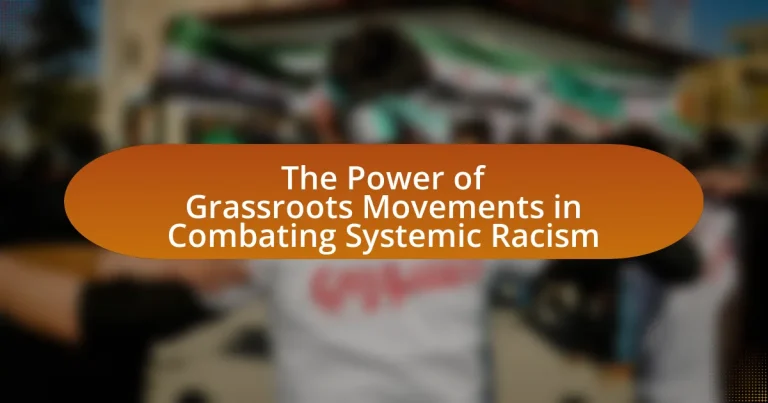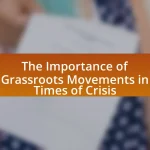Grassroots movements are organized efforts by ordinary individuals at the community level aimed at achieving social or political change, particularly in combating systemic racism. This article explores the emergence, significance, and strategies of grassroots movements, highlighting their role in advocating for civil rights and social justice. Key factors contributing to the formation of these movements include social injustice, community mobilization, and shared identity, while their objectives are shaped by local community needs. The article also examines the challenges faced by grassroots movements, such as limited resources and institutional resistance, and discusses best practices for effective activism, including coalition-building and community engagement. Historical examples, such as the Civil Rights Movement and the Black Lives Matter movement, illustrate the impact of grassroots activism on systemic racism and the importance of sustained community involvement in driving meaningful change.
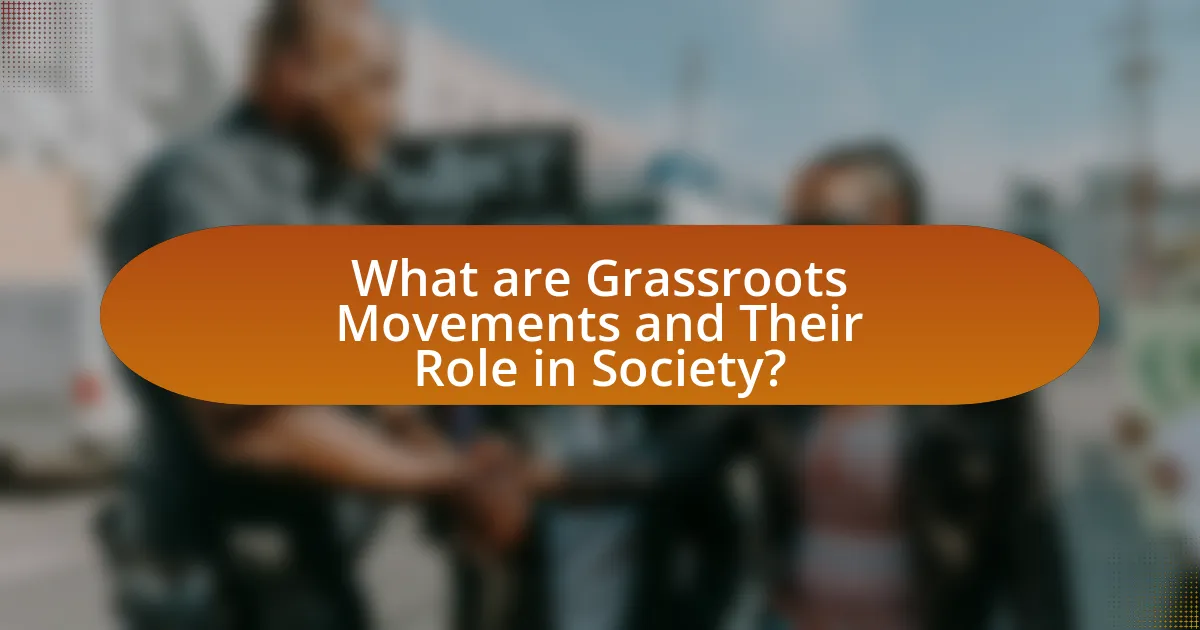
What are Grassroots Movements and Their Role in Society?
Grassroots movements are organized efforts by ordinary people at the community level to effect social or political change. These movements play a crucial role in society by mobilizing individuals to advocate for issues such as civil rights, environmental justice, and systemic racism. For instance, the Civil Rights Movement in the United States, which gained momentum in the 1950s and 1960s, exemplifies how grassroots activism can lead to significant legislative changes, such as the Civil Rights Act of 1964. Grassroots movements empower marginalized voices, foster community engagement, and often serve as catalysts for broader societal transformation.
How do grassroots movements emerge in response to systemic issues?
Grassroots movements emerge in response to systemic issues when communities mobilize to address perceived injustices and inequalities. These movements often arise from collective experiences of marginalization, prompting individuals to organize and advocate for change. For instance, the Civil Rights Movement in the United States emerged in the 1950s and 1960s as a direct response to systemic racism and segregation, driven by grassroots organizations like the NAACP and grassroots leaders such as Martin Luther King Jr. This historical context illustrates how systemic oppression can catalyze community action, leading to organized efforts aimed at dismantling discriminatory practices and policies.
What factors contribute to the formation of grassroots movements?
Grassroots movements form due to a combination of social injustice, community mobilization, and shared identity among individuals. Social injustice, such as systemic racism, often serves as a catalyst, prompting individuals to unite in response to perceived inequalities. Community mobilization is essential, as it involves organizing local efforts and resources to address specific issues, fostering a sense of collective action. Shared identity, whether based on race, ethnicity, or common experiences, strengthens the bonds among participants, enhancing solidarity and commitment to the cause. Historical examples, such as the Civil Rights Movement in the United States, illustrate how these factors converge to create powerful grassroots initiatives aimed at combating systemic oppression.
How do community needs shape the objectives of grassroots movements?
Community needs directly shape the objectives of grassroots movements by prioritizing the specific issues and challenges faced by local populations. Grassroots movements emerge in response to the unique social, economic, and political contexts of communities, ensuring that their goals align with the immediate concerns of those they represent. For instance, movements addressing systemic racism often focus on issues such as police brutality, access to education, and economic inequality, which are identified through community engagement and dialogue. Research indicates that successful grassroots initiatives, like the Black Lives Matter movement, have effectively mobilized around community-defined needs, leading to significant policy changes and increased awareness of racial injustices. This alignment between community needs and movement objectives fosters greater participation and support, ultimately enhancing the effectiveness of the movement in achieving its goals.
Why are grassroots movements important in combating systemic racism?
Grassroots movements are crucial in combating systemic racism because they mobilize communities to advocate for change from the ground up. These movements empower individuals to challenge discriminatory practices and policies, fostering collective action that can lead to significant social and political reforms. For instance, the Civil Rights Movement in the United States, which was largely driven by grassroots organizations, successfully challenged segregation laws and led to the passage of the Civil Rights Act of 1964. This historical example illustrates how grassroots efforts can effectively address systemic issues by raising awareness, influencing public opinion, and pressuring policymakers to enact equitable legislation.
What historical examples illustrate the impact of grassroots movements on systemic racism?
Grassroots movements have significantly impacted systemic racism throughout history, with notable examples including the Civil Rights Movement in the United States and the anti-apartheid movement in South Africa. The Civil Rights Movement, particularly from the 1950s to the 1960s, mobilized individuals and organizations to challenge racial segregation and discrimination, leading to landmark legislation such as the Civil Rights Act of 1964 and the Voting Rights Act of 1965. These laws dismantled institutional barriers and provided legal protections against racial discrimination. Similarly, the anti-apartheid movement in South Africa, driven by grassroots activism, culminated in the end of apartheid in the early 1990s, resulting in the election of Nelson Mandela as the first Black president in 1994. This movement showcased the power of collective action in dismantling systemic racial oppression and achieving political change.
How do grassroots movements empower marginalized communities?
Grassroots movements empower marginalized communities by providing them with a platform to voice their concerns and advocate for their rights. These movements facilitate collective action, enabling individuals to unite around common issues such as systemic racism, economic inequality, and social justice. For instance, the Black Lives Matter movement has mobilized communities across the globe to address police brutality and racial discrimination, leading to significant policy changes and increased awareness of racial issues. Research indicates that grassroots activism can lead to tangible outcomes, such as the passing of legislation aimed at reducing racial disparities, thereby validating the effectiveness of these movements in empowering marginalized groups.
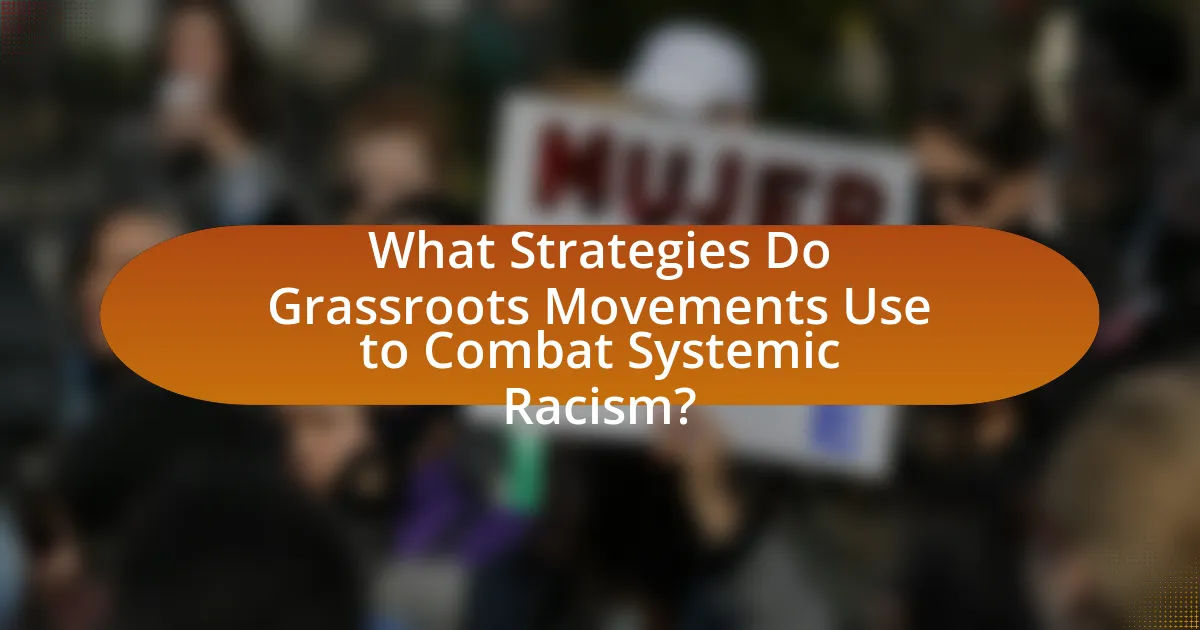
What Strategies Do Grassroots Movements Use to Combat Systemic Racism?
Grassroots movements combat systemic racism through strategies such as community organizing, advocacy, education, and coalition-building. Community organizing involves mobilizing individuals to raise awareness and take collective action against racial injustices, exemplified by movements like Black Lives Matter, which has effectively highlighted police brutality and systemic inequality. Advocacy efforts focus on influencing policy changes at local, state, and national levels, as seen in campaigns for criminal justice reform and equitable education funding. Education initiatives aim to inform and empower communities about their rights and the impacts of systemic racism, often utilizing workshops and social media to disseminate information. Coalition-building fosters alliances among diverse groups, enhancing the collective power to challenge systemic issues, as demonstrated by the collaboration between various civil rights organizations during protests and legislative efforts. These strategies are supported by historical evidence of successful grassroots campaigns leading to significant social and legislative changes, such as the Civil Rights Movement’s impact on desegregation laws in the 1960s.
How do grassroots movements mobilize community support?
Grassroots movements mobilize community support by fostering local engagement and building relationships among community members. These movements often utilize strategies such as organizing community meetings, leveraging social media for outreach, and creating coalitions with local organizations to amplify their message. For instance, the Black Lives Matter movement effectively mobilized support through social media campaigns and local protests, which raised awareness about systemic racism and encouraged community participation. Research indicates that grassroots efforts can lead to increased civic engagement, as seen in the 2017 Women’s March, which drew millions of participants globally, demonstrating the power of collective action in addressing social issues.
What role does social media play in grassroots mobilization?
Social media serves as a critical tool for grassroots mobilization by facilitating rapid communication, organization, and engagement among activists and supporters. It enables grassroots movements to disseminate information quickly, rally support, and coordinate actions, often reaching a wider audience than traditional methods. For instance, during the Black Lives Matter movement, social media platforms like Twitter and Facebook were instrumental in organizing protests and sharing real-time updates, leading to significant public participation and awareness. Studies have shown that social media can amplify voices that are often marginalized, making it a powerful mechanism for driving social change and mobilizing communities against systemic racism.
How do grassroots movements utilize local resources for advocacy?
Grassroots movements utilize local resources for advocacy by mobilizing community members, leveraging local knowledge, and forming partnerships with local organizations. These movements often rely on the active participation of residents who understand the specific issues affecting their communities, which enhances the relevance and impact of their advocacy efforts. For example, the Black Lives Matter movement has effectively used local networks to organize protests and educational events, drawing on the experiences and voices of community members to address systemic racism. Additionally, grassroots movements often collaborate with local businesses, schools, and nonprofits to amplify their message and resources, creating a united front against systemic injustices. This localized approach not only fosters community engagement but also ensures that advocacy efforts are grounded in the realities faced by those directly affected by systemic racism.
What methods do grassroots movements employ to raise awareness?
Grassroots movements employ various methods to raise awareness, including social media campaigns, community organizing, public demonstrations, and educational workshops. Social media campaigns leverage platforms like Twitter and Facebook to disseminate information rapidly, reaching a wide audience and facilitating engagement. Community organizing involves mobilizing local residents to participate in discussions and actions that highlight systemic racism, fostering a sense of solidarity and collective action. Public demonstrations, such as marches and rallies, visually represent the movement’s goals and draw media attention, amplifying their message. Educational workshops provide participants with knowledge about systemic racism and equip them with tools to advocate for change, thereby increasing awareness and understanding within the community. These methods have proven effective in raising awareness and mobilizing support for anti-racist initiatives.
How do educational campaigns contribute to the goals of grassroots movements?
Educational campaigns significantly enhance the goals of grassroots movements by raising awareness and mobilizing community action against systemic racism. These campaigns educate individuals about the historical and social contexts of racism, empowering them to recognize and challenge discriminatory practices. For instance, the “Black Lives Matter” movement utilizes educational initiatives to inform the public about police brutality and racial inequality, fostering a collective understanding that drives activism. Research indicates that informed communities are more likely to engage in advocacy and policy change, as seen in the increased voter turnout and participation in protests following educational outreach efforts. Thus, educational campaigns serve as a vital tool in equipping grassroots movements with the knowledge and support necessary to effect meaningful change.
What role do protests and demonstrations play in grassroots activism?
Protests and demonstrations serve as critical tools for grassroots activism by mobilizing community members, raising awareness, and influencing public policy. These collective actions create visibility for social issues, particularly systemic racism, by drawing media attention and public discourse. For instance, the Black Lives Matter movement utilized protests to highlight police brutality and racial injustice, leading to significant policy discussions and reforms in various jurisdictions. Historical evidence shows that protests have historically catalyzed change, such as the Civil Rights Movement, where demonstrations were pivotal in achieving legislative milestones like the Civil Rights Act of 1964. Thus, protests and demonstrations are essential for grassroots movements to amplify their voices and effect tangible societal change.
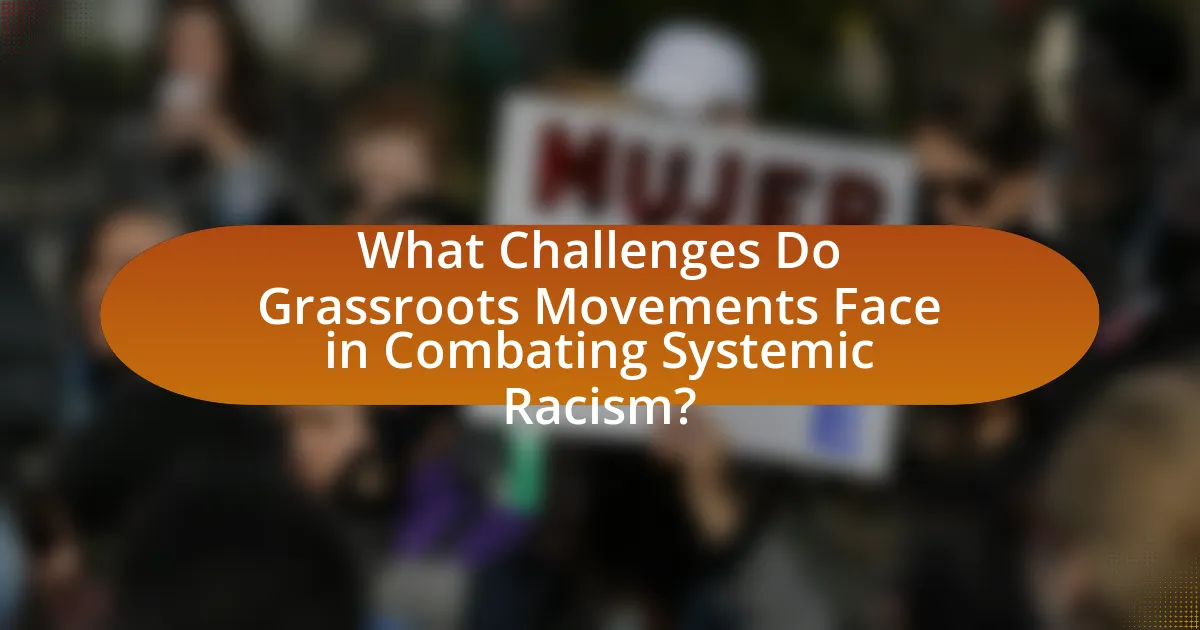
What Challenges Do Grassroots Movements Face in Combating Systemic Racism?
Grassroots movements face significant challenges in combating systemic racism, primarily due to limited resources, institutional resistance, and fragmentation within the movement itself. Limited financial and human resources hinder the ability of grassroots organizations to sustain long-term campaigns and outreach efforts. Institutional resistance manifests through legal and political barriers that obstruct reform initiatives, as seen in cases where local governments have actively opposed policy changes advocated by these movements. Additionally, fragmentation occurs when differing ideologies and strategies among various groups lead to a lack of unified action, weakening the overall impact. For instance, the Black Lives Matter movement has faced internal divisions that complicate its objectives and messaging, making it harder to present a cohesive front against systemic racism.
What obstacles hinder the effectiveness of grassroots movements?
Grassroots movements face several obstacles that hinder their effectiveness, including limited funding, lack of media coverage, and internal divisions. Limited funding restricts the ability of these movements to organize events, mobilize supporters, and sustain long-term campaigns, as evidenced by a study from the National Committee for Responsive Philanthropy, which found that only a small percentage of philanthropic funding goes to grassroots organizations. Lack of media coverage diminishes public awareness and support, making it difficult for movements to gain traction; for instance, mainstream media often overlooks local initiatives in favor of larger, more sensational stories. Internal divisions, such as differing priorities and strategies among members, can lead to fragmentation and weaken collective action, as seen in various social movements where factions have emerged over ideological differences.
How does systemic oppression impact grassroots efforts?
Systemic oppression significantly undermines grassroots efforts by creating barriers to access, resources, and participation. Grassroots movements often rely on community engagement and mobilization, but systemic oppression can marginalize certain groups, limiting their ability to organize effectively. For example, systemic racism can lead to discriminatory practices in funding and support, as seen in studies showing that organizations led by people of color receive less financial backing compared to their white counterparts. This disparity restricts the capacity of grassroots initiatives to address issues within their communities, ultimately hindering their effectiveness in combating systemic racism.
What are the challenges of sustaining momentum in grassroots movements?
Sustaining momentum in grassroots movements faces several challenges, including resource limitations, leadership turnover, and external opposition. Resource limitations often hinder the ability to maintain outreach and engagement, as many grassroots organizations operate on tight budgets and rely on volunteer efforts. Leadership turnover can disrupt continuity and weaken the movement’s focus, as new leaders may bring different priorities or strategies. Additionally, external opposition from established institutions or counter-movements can create significant barriers, leading to demoralization among participants. These challenges are evident in various historical contexts, such as the Civil Rights Movement, where funding shortages and internal divisions impacted the effectiveness of campaigns.
How can grassroots movements overcome these challenges?
Grassroots movements can overcome challenges by fostering community engagement and building coalitions. Engaging local communities ensures that diverse voices are heard, which strengthens the movement’s legitimacy and support. For instance, the Black Lives Matter movement effectively mobilized grassroots support through social media campaigns and local organizing, leading to widespread protests and policy discussions. Additionally, forming coalitions with other organizations amplifies resources and influence, as seen in the collaboration between various civil rights groups during the Civil Rights Movement, which significantly advanced legislative changes. These strategies demonstrate that grassroots movements can effectively navigate obstacles by leveraging community involvement and strategic partnerships.
What strategies can be implemented to enhance resilience in grassroots movements?
To enhance resilience in grassroots movements, organizations should implement strategies such as building strong community networks, fostering inclusive leadership, and utilizing adaptive communication methods. Strong community networks create a support system that can mobilize resources and share knowledge effectively, as seen in the success of movements like Black Lives Matter, which leveraged local chapters to coordinate actions and share strategies. Inclusive leadership ensures diverse perspectives are represented, which strengthens the movement’s adaptability and relevance, evidenced by the varied coalitions formed during the Women’s March. Adaptive communication methods, including social media engagement and grassroots storytelling, allow movements to respond quickly to challenges and maintain public interest, as demonstrated by the rapid dissemination of information during protests. These strategies collectively contribute to the sustainability and impact of grassroots movements in combating systemic racism.
How can collaboration with other organizations strengthen grassroots efforts?
Collaboration with other organizations can significantly strengthen grassroots efforts by pooling resources, expertise, and networks to amplify impact. When grassroots movements partner with established organizations, they gain access to funding, training, and advocacy tools that enhance their capacity to address systemic racism effectively. For instance, the collaboration between grassroots groups and larger nonprofits has historically led to successful campaigns, such as the Civil Rights Movement, where alliances with organizations like the NAACP provided critical legal support and national visibility. This synergy not only increases the reach of grassroots initiatives but also fosters a united front that can influence policy changes and mobilize broader community engagement.
What are some best practices for effective grassroots activism against systemic racism?
Effective grassroots activism against systemic racism involves building strong community coalitions, utilizing social media for awareness, and engaging in direct action. Community coalitions foster collaboration among diverse groups, enhancing the collective impact of efforts. For instance, the Black Lives Matter movement successfully mobilized various organizations to address police violence and systemic inequality. Social media platforms amplify messages and organize events, as seen in the widespread participation during protests following George Floyd’s death in 2020. Direct action, such as peaceful protests and community forums, creates visibility and encourages dialogue, which can lead to policy changes. Research indicates that grassroots movements can significantly influence public opinion and legislative outcomes, demonstrating their effectiveness in combating systemic racism.
How can grassroots movements build inclusive coalitions?
Grassroots movements can build inclusive coalitions by actively engaging diverse community members and fostering open dialogue. This approach ensures that various perspectives are represented, which is crucial for addressing systemic racism effectively. For instance, successful coalitions often utilize strategies such as community forums, workshops, and collaborative projects that invite participation from marginalized groups. Research indicates that inclusive coalitions, like those formed during the Civil Rights Movement, were more effective in mobilizing support and achieving legislative changes, demonstrating the power of collective action across different demographics.
What role does community engagement play in successful grassroots initiatives?
Community engagement is crucial for the success of grassroots initiatives as it fosters collaboration, builds trust, and mobilizes resources within the community. Engaged communities are more likely to participate actively in initiatives, leading to increased ownership and accountability. For instance, research by the Stanford Social Innovation Review highlights that grassroots movements that prioritize community involvement often achieve greater impact, as seen in the success of organizations like Black Lives Matter, which effectively mobilized community support to address systemic racism. This active participation not only amplifies voices but also ensures that initiatives are relevant and responsive to the specific needs of the community, thereby enhancing their effectiveness.
